| | Introduction | Alberta retail grocery sales data (2009-2012) | How do Canadians rank with eating fresh fruit and vegetables? | Has the trend continued in 2013? | So what? | Sources
.
Introduction
Market trends may not be just a passing fad, but an indication of how consumers and the markets are changing over time. They help producers and processors identify opportunities, strategically plan, and better align their products and services.
In this issue, market trends for fruits and vegetables are presented based on selected market research reports.
Alberta Retail Grocery Sales Data (2009-2012)
Alberta Retail Grocery Sales from 2009 to 2012 have grown to $7.1 billion. Fresh produce is a growing sector, which accounts for over $1 billion, or 14.6% of the total retail grocery sales.
Alberta Grocery Retail Sales Value (Billion Dollars)
2009 to 2012
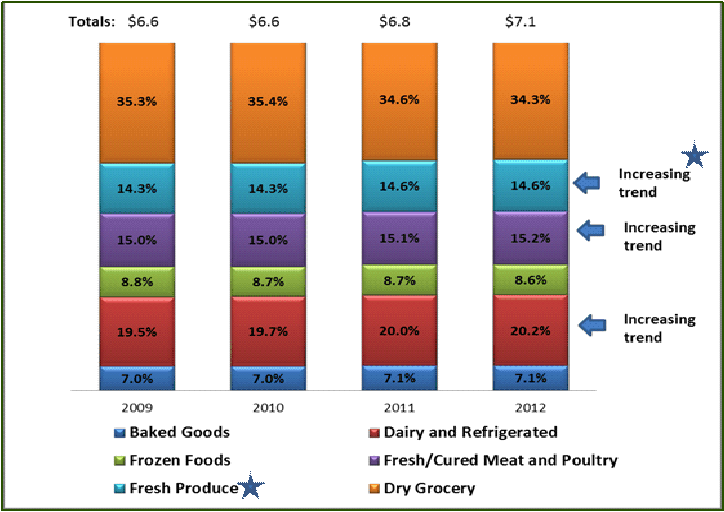
Source: Alberta Retail Grocery Sales Data, Nielsen Market Track, Alberta All Channels
Alberta Retail Grocery Sales from 2009 to 2012 have grown to $7.1 billion. Fresh produce is a growing sector, which accounts for over $1 billion, or 14.6% of the total retail grocery sales.
Fresh Produce Sales in Alberta
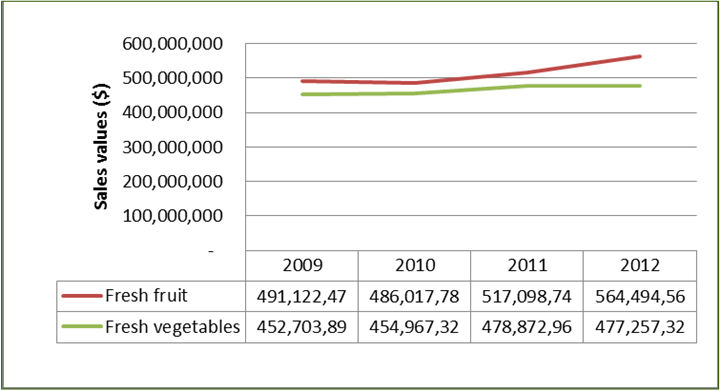
Source: Alberta Retail Grocery Sales Data, Nielsen Market Track, Alberta All Channels, 2009-2012
By 2012, fresh fruit sales alone account for $564 million; fresh vegetables account for $477 million.
Sales ($) of Other Fruit/Vegetable Products in Alberta
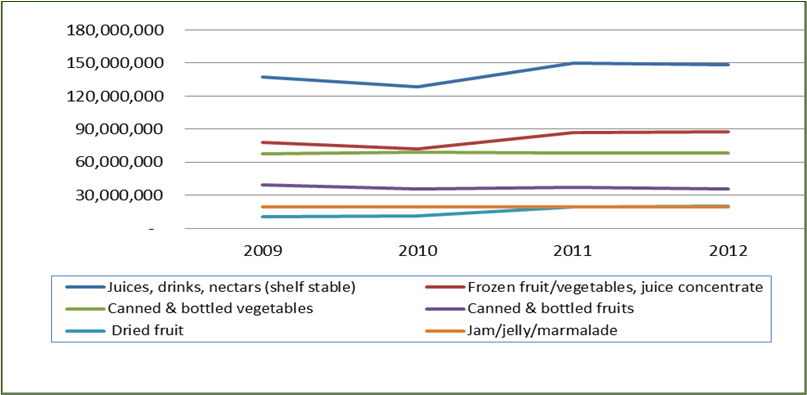
Source: Alberta Retail Grocery Sales Data, Nielsen Market Track, Alberta All Channels, 2009-2012
Sales of other processed fruit and vegetable products account for another $340 million. The chart shows increased sales in: juices/drinks/nectars; dried fruit; and in the frozen category (mostly in juice concentrate and frozen fruit).
Fresh Fruits Sales (million dollars) 2009 to 2012
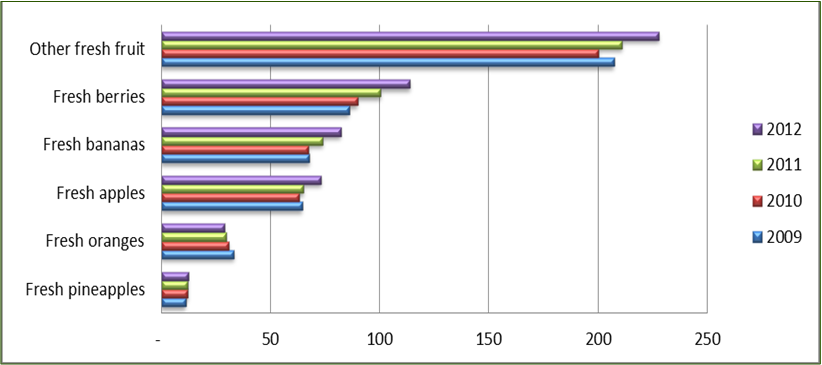
| Source: Alberta Retail Grocery Sales Data, Nielsen Market Track, Alberta All Channels, 2009-2012
Fresh Vegetables Sales ( million dollars) 2009 to 2012
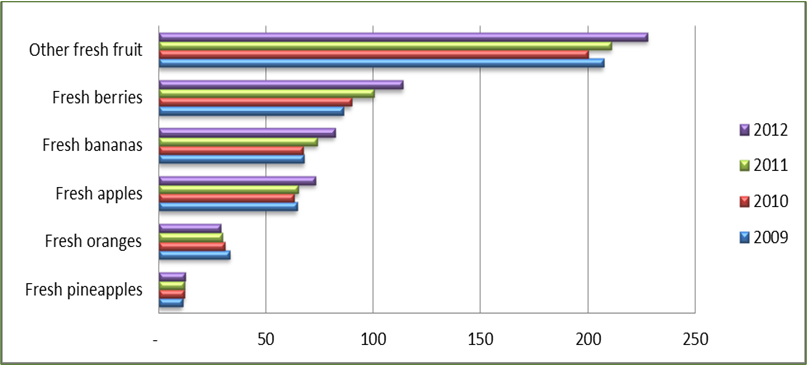 |
Source: Alberta Retail Grocery Sales Data, Nielsen Market Track, Alberta All Channels, 2009-2012
Alberta has seen an increase in consumer demand for fresh fruit and vegetable sales since 2009. This demand is especially noteworthy for Alberta producers producing berries and apples, whether they are sold in the retail market or direct markets. Vegetables also show a steady increase since 2009.
How do Canadians Rank with Eating Fresh Fruit and Vegetables?
Breakfast – “ Ready to eat” cereal is still the top breakfast food (31%) followed by toast (23%), fruit (16%) and hot cereals (10%). Compared to the average population, fresh fruit is eaten less often by 18-44 year olds, eaten on average by 45-64 year olds, and more than the average population by 65+ year olds.
Lunch – One third of lunches include a sandwich, while fruit ranks second place or is one-fifth of lunch occasions (19%) while vegetables is at 13 percent.
Supper or Carried from Home – Vegetables and salads are more popular with seniors than the average population; they are eaten less by those 34 or under. As a main dish, while chicken is first (12%), vegetables in second place (9%). On the other hand, vegetables are a side dish half of the time (50%) with salads following second as a side (19%).
Snacks – fruit is the top ranking snack eaten by Canadians, usually as morning or afternoon snack, while evening snacks tend to be more indulgent.
Has the Trend Continued in 2013?
As of December 2013, retail stores reported their top performers. Produce leads growth with fresh vegetables and fruit is also outperforming the market compared to other categories.
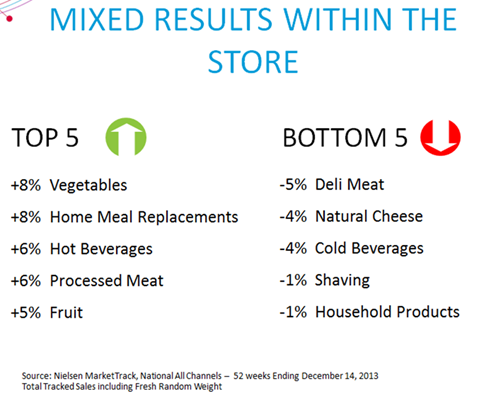
As of December 2013, retail stores reported their top performers. Produce leads growth with fresh vegetables and fruit is also outperforming the market compared to other categories.
So What?
- It is important to understand whether your category is affected by trends, and how it is shaped by changing consumer demographics and preferences.
- With the increasing demand for fresh produce in retail, there lies an opportunity for locally grown fruit and vegetables.
- Other fruit and vegetable products also show promise by increased sales since 2009, especially juice products, frozen juice concentrate, frozen fruit, and dried fruit.
- By looking at consumer demographics and ways to make products convenient business can better meet consumers’ needs.
- Breakfast – fruit is a popular item especially for 45+ years of age
- Lunch – fruit and vegetables are common for the general population; fruit makes up one-fifth of lunch occasions (19%), while vegetables make up 13%.
- Supper – vegetables often come in second place on a dinner plate (9%), while salads are a side dish half of the time (50%) or as a side dish (19%).
Sources:
- Alberta Retail Grocery Sales Data, Nielsen Market Track, Alberta All Channels, 2009-2012
- Source: The NPD Group/SnackTrack – Canada. December 2011.
|
|